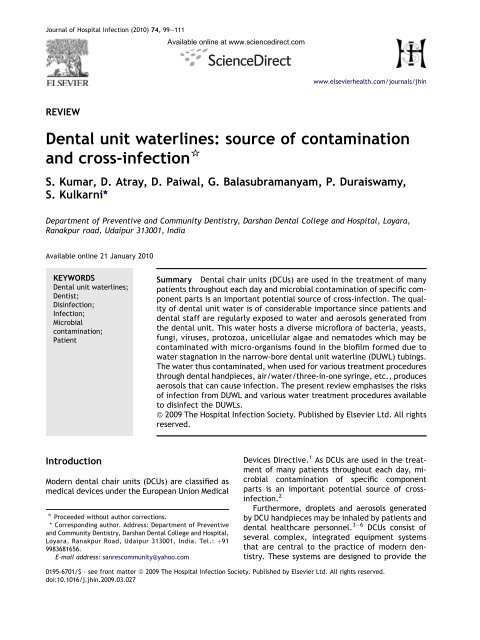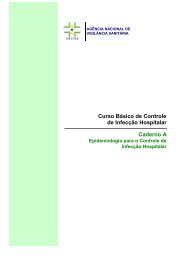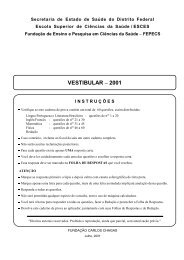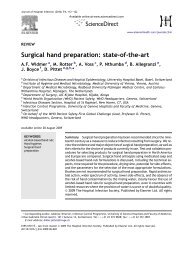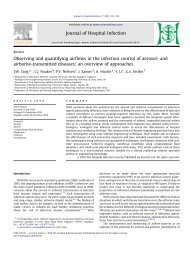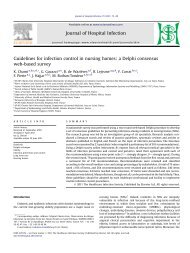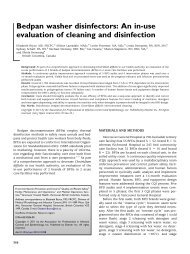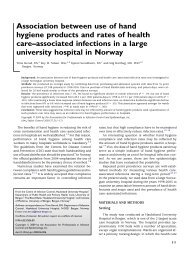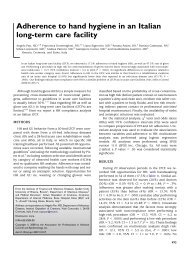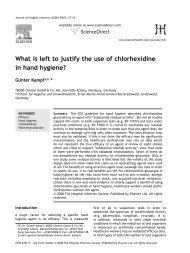Dental unit waterlines: source of contamination and cross ... - CCIH
Dental unit waterlines: source of contamination and cross ... - CCIH
Dental unit waterlines: source of contamination and cross ... - CCIH
Create successful ePaper yourself
Turn your PDF publications into a flip-book with our unique Google optimized e-Paper software.
Journal <strong>of</strong> Hospital Infection (2010) 74, 99e111<br />
REVIEW<br />
<strong>Dental</strong> <strong>unit</strong> <strong>waterlines</strong>: <strong>source</strong> <strong>of</strong> <strong>contamination</strong><br />
<strong>and</strong> <strong>cross</strong>-infection *<br />
S. Kumar, D. Atray, D. Paiwal, G. Balasubramanyam, P. Duraiswamy,<br />
S. Kulkarni*<br />
Department <strong>of</strong> Preventive <strong>and</strong> Comm<strong>unit</strong>y Dentistry, Darshan <strong>Dental</strong> College <strong>and</strong> Hospital, Loyara,<br />
Ranakpur road, Udaipur 313001, India<br />
Available online 21 January 2010<br />
KEYWORDS<br />
<strong>Dental</strong> <strong>unit</strong> <strong>waterlines</strong>;<br />
Dentist;<br />
Disinfection;<br />
Infection;<br />
Microbial<br />
<strong>contamination</strong>;<br />
Patient<br />
Introduction<br />
Modern dental chair <strong>unit</strong>s (DCUs) are classified as<br />
medical devices under the European Union Medical<br />
* Proceeded without author corrections.<br />
* Corresponding author. Address: Department <strong>of</strong> Preventive<br />
<strong>and</strong> Comm<strong>unit</strong>y Dentistry, Darshan <strong>Dental</strong> College <strong>and</strong> Hospital,<br />
Loyara, Ranakpur Road, Udaipur 313001, India. Tel.: þ91<br />
9983681656.<br />
E-mail address: sanrescomm<strong>unit</strong>y@yahoo.com<br />
Available online at www.sciencedirect.com<br />
www.elsevierhealth.com/journals/jhin<br />
Summary <strong>Dental</strong> chair <strong>unit</strong>s (DCUs) are used in the treatment <strong>of</strong> many<br />
patients throughout each day <strong>and</strong> microbial <strong>contamination</strong> <strong>of</strong> specific component<br />
parts is an important potential <strong>source</strong> <strong>of</strong> <strong>cross</strong>-infection. The quality<br />
<strong>of</strong> dental <strong>unit</strong> water is <strong>of</strong> considerable importance since patients <strong>and</strong><br />
dental staff are regularly exposed to water <strong>and</strong> aerosols generated from<br />
the dental <strong>unit</strong>. This water hosts a diverse micr<strong>of</strong>lora <strong>of</strong> bacteria, yeasts,<br />
fungi, viruses, protozoa, unicellular algae <strong>and</strong> nematodes which may be<br />
contaminated with micro-organisms found in the bi<strong>of</strong>ilm formed due to<br />
water stagnation in the narrow-bore dental <strong>unit</strong> waterline (DUWL) tubings.<br />
The water thus contaminated, when used for various treatment procedures<br />
through dental h<strong>and</strong>pieces, air/water/three-in-one syringe, etc., produces<br />
aerosols that can cause infection. The present review emphasises the risks<br />
<strong>of</strong> infection from DUWL <strong>and</strong> various water treatment procedures available<br />
to disinfect the DUWLs.<br />
ª 2009 The Hospital Infection Society. Published by Elsevier Ltd. All rights<br />
reserved.<br />
Devices Directive. 1 As DCUs are used in the treatment<br />
<strong>of</strong> many patients throughout each day, microbial<br />
<strong>contamination</strong> <strong>of</strong> specific component<br />
parts is an important potential <strong>source</strong> <strong>of</strong> <strong>cross</strong>infection.<br />
2<br />
Furthermore, droplets <strong>and</strong> aerosols generated<br />
by DCU h<strong>and</strong>pieces may be inhaled by patients <strong>and</strong><br />
dental healthcare personnel. 3e6 DCUs consist <strong>of</strong><br />
several complex, integrated equipment systems<br />
that are central to the practice <strong>of</strong> modern dentistry.<br />
These systems are designed to provide the<br />
0195-6701/$ - see front matter ª 2009 The Hospital Infection Society. Published by Elsevier Ltd. All rights reserved.<br />
doi:10.1016/j.jhin.2009.03.027
100 S. Kumar et al.<br />
instruments <strong>and</strong> services necessary for a diverse<br />
range <strong>of</strong> dental procedures.<br />
The quality <strong>of</strong> dental <strong>unit</strong> water (DUW) is <strong>of</strong><br />
considerable importance since patients <strong>and</strong> dental<br />
staff are regularly exposed to water <strong>and</strong> aerosols<br />
generated from the dental <strong>unit</strong>.<br />
This water hosts a diverse micr<strong>of</strong>lora <strong>of</strong> bacteria,<br />
yeasts, fungi, viruses, protozoa, unicellular algae<br />
<strong>and</strong> nematodes.<br />
Water with
<strong>Dental</strong> <strong>unit</strong> <strong>waterlines</strong> 101<br />
H<strong>and</strong>piece Syringe Scaler Basin<br />
Compressed<br />
air<br />
Shut-<strong>of</strong>f valve<br />
Bi<strong>of</strong>ilms in DUW<br />
Bacteria in aquatic environments interact with<br />
surfaces to form a bi<strong>of</strong>ilm, a strategy developed<br />
to aid survival <strong>and</strong> to optimise available nutrients.<br />
The physics <strong>of</strong> laminar flow <strong>of</strong> DUW passing through<br />
the <strong>waterlines</strong> results in maximum flow at the<br />
centre <strong>of</strong> the lumen <strong>and</strong> minimal flow at the<br />
periphery, encouraging deposition <strong>of</strong> organisms<br />
onto the surface <strong>of</strong> the tubing. 16 Intermittent use<br />
patterns <strong>of</strong> dental lines leads to stagnation <strong>of</strong> the<br />
entire water column within the <strong>waterlines</strong> for extended<br />
periods during the day, thus promoting further<br />
undisturbed bacterial proliferation. Bacteria<br />
adhere more readily to hydrophobic polymeric<br />
plastic tubing <strong>of</strong> the type used in dental equipment<br />
(for example, polyvinyl chloride, polyurethane)<br />
than to those composed <strong>of</strong> glass or steel. 17 Susceptibility<br />
<strong>of</strong> medical equipment such as catheters to<br />
bi<strong>of</strong>ilms has been reduced by coating with heavy<br />
metals or incorporating biocides into the fabric<br />
<strong>of</strong> the tubing that inhibit bacterial growth. 18 Similar<br />
materials may be <strong>of</strong> future value in dental<br />
<strong>unit</strong>s. Organisms in DUW bi<strong>of</strong>ilm are predominantly<br />
derived from the incoming mains water. Once<br />
a new DUW system is connected to mains water<br />
supply, even when it is not used for patient treatment,<br />
a bi<strong>of</strong>ilm will form (<strong>and</strong> be releasing high<br />
numbers <strong>of</strong> planktonic organisms) within 8 h. 19<br />
The bi<strong>of</strong>ilm will develop to reach a climax comm<strong>unit</strong>y<br />
<strong>of</strong> microcolonies embedded in a protective<br />
R<br />
e<br />
s<br />
e<br />
r<br />
v<br />
o<br />
i<br />
r<br />
Silver<br />
compound<br />
added as<br />
liquid, powder<br />
or tablet<br />
Figure 1 <strong>Dental</strong> chair <strong>unit</strong> water supply.<br />
extracellar amorphous matrix by six days. 19 Bacteria<br />
shed from the bi<strong>of</strong>ilm during use maintain<br />
the bioburden <strong>of</strong> planktonic (suspended) organisms<br />
detected in DUW. Characteristically bi<strong>of</strong>ilm bacteria<br />
exhibit greater resistance to surfactants, biocides<br />
<strong>and</strong> antibiotics than organisms floating<br />
freely in fluids. 20 Various types <strong>of</strong> organisms isolated<br />
from DUW are listed in Table I.<br />
Bacterial indicators <strong>of</strong> risk<br />
In potable water supplies, concentrations <strong>of</strong> >1coliform/100<br />
mL suggest faecal/sewage <strong>contamination</strong>.<br />
However, coliforms are not usually recovered from<br />
DUWL, excepting unusual circumstances, e.g.<br />
Table I Types <strong>of</strong> organisms isolated from dental<br />
<strong>unit</strong> water<br />
Bacteria Fungi Protozoa<br />
Achromobacter Phoma spp. Acanthamoeba<br />
xyloxidans Penicillium spp.<br />
Acinetobacter spp. Cryptosporidium<br />
spp.<br />
Cladosporium spp.<br />
Actinomyces spp. Microsporidium<br />
spp.<br />
Alternaria spp.<br />
Alicaligenes<br />
dentrificans<br />
Bacillus spp.<br />
Bacteroides spp.<br />
Caulobacter spp.<br />
Flavobacterium<br />
spp.<br />
Fusobacterium<br />
spp.<br />
Klebsiella<br />
pneumoniae<br />
Lactobacillus<br />
spp.<br />
Legionella spp.<br />
Micrococcus spp.<br />
Moraxella spp.<br />
Mycobacterium<br />
avium<br />
Nocardia spp.<br />
Pasteurella spp.<br />
Proteus vulgaris<br />
Pseudomonas<br />
aeruginosa<br />
Burkholderia<br />
cepacia<br />
Streptococcus<br />
spp.<br />
Staphylococcus<br />
aureus<br />
Mycobacterium<br />
spp.<br />
Xanthomonas spp.<br />
spp. Giardia spp.<br />
Scopulariopsis<br />
spp.
102 S. Kumar et al.<br />
following manual manipulation <strong>of</strong> independent reservoir<br />
bottles by staff with poor h<strong>and</strong> hygiene. Reliance<br />
solely on the aerobic count in DUWL as an indicator <strong>of</strong><br />
the associated health risks may underestimate the<br />
risk, as aerobic counts will not highlight the presence<br />
<strong>of</strong> respiratory <strong>and</strong> opportunistic pathogens. Isolation<br />
<strong>of</strong> the latter organisms in water intended for irrigation<br />
<strong>of</strong> a medical device such as a dental h<strong>and</strong>piece may<br />
constitute both an infection control risk <strong>and</strong> health<br />
hazard. 21 DUWL contaminated with 30% <strong>of</strong> opportunistic<br />
pathogens such as Pseudomonas spp. or Legionella<br />
spp. are likely to constitute a greater health risk<br />
to staff <strong>and</strong> patients than DUWL with a high bacterial<br />
count <strong>of</strong> millions <strong>of</strong> organisms per/mL in the absence<br />
<strong>of</strong> known pathogens. An alternative approach for risk<br />
assessment <strong>and</strong> management is to use epidemiological<br />
<strong>and</strong> serological techniques to screen for evidence<br />
<strong>of</strong> DUWL-associated infection in both the dental team<br />
<strong>and</strong> dental patients.<br />
What are the risks to patients?<br />
There is no evidence <strong>of</strong> a widespread public health<br />
problem from exposure to DUW. Nevertheless, the<br />
goal <strong>of</strong> infection control is to minimise the risk<br />
from exposure to potential pathogens <strong>and</strong> to<br />
create a safe working environment in which to<br />
treat patients. The ever-increasing number <strong>of</strong><br />
patients who are either immunocompromised or<br />
immunosuppressed due to drug therapy, alcohol<br />
abuse or systemic disease has produced a cohort <strong>of</strong><br />
patients susceptible to environmental waterborne<br />
opportunistic pathogens such as those prevailing in<br />
DUW. The organisms recovered from DUW vary<br />
with geographic location. They include fungi, freeliving<br />
amoebae, protozoa <strong>and</strong> nematodes as well<br />
as the consistently reported recovery <strong>of</strong> saprophytic<br />
<strong>and</strong> opportunistic Gram-negative pathogens<br />
such as Pseudomonas spp., Klebsiella spp. <strong>and</strong> Flavobacterium<br />
spp.. 22 Of particular concern are the<br />
primary respiratory environmental pathogens<br />
found in DUW that can cause pneumonia, milder<br />
flu-like respiratory infection <strong>and</strong>, less commonly,<br />
wound infections, e.g. Legionella pneumophila<br />
<strong>and</strong> non-pneumophila Legionella spp. as well as<br />
Mycobacterium spp. including Mycobacterium<br />
avium-intracellulare. Mycobacterium avium-intracellulare<br />
can cause disseminated infection in<br />
HIV-seropositive patients following ingestion <strong>and</strong><br />
colonisation <strong>of</strong> the gut. 23,24 Numbers <strong>of</strong> non-tuberculous<br />
mycobacterium (NTM) in DUW exceeded<br />
that <strong>of</strong> drinking water by a factor <strong>of</strong> 400. 25 High<br />
numbers <strong>of</strong> non-tuberculous mycobacteria may<br />
be swallowed, inhaled or inoculated into oral<br />
wounds during dental treatment with the potential<br />
for colonisation, infection or immunisation. Priming<br />
<strong>of</strong> the immune system by exposure to environmental<br />
NTM helps to maintain the anti-tuberculin<br />
immune response. 26 The true extent <strong>of</strong> the risk<br />
posed by NTM in DUW to the immunocompromised<br />
patient has yet to be fully elucidated. Similarly,<br />
the primary pathogen acanthamoeba is recovered<br />
from DUW <strong>and</strong> bi<strong>of</strong>ilm. 22 These organisms are<br />
reputed to cause amoebic keratitis in contact<br />
lens wearers who clean their lenses in tap water. 27<br />
It is unknown whether they present a risk in the<br />
dental setting, but routine use <strong>of</strong> protective eye<br />
wear by both the dental team <strong>and</strong> patients should<br />
shield the eyes from any possible exposure.<br />
Pseudomonas aeruginosa<br />
This can be highly resistant to biocides, including<br />
antibiotics, <strong>and</strong> can grow in dilute disinfectants<br />
such as chlorhexidine <strong>and</strong> iodophors. It is able to<br />
thrive in low nutrient environments such as distilled<br />
water, which is <strong>of</strong>ten used by dentists in<br />
bottled-water systems.<br />
The infective dose for colonisation in healthy<br />
human volunteers is >1.5 10 6 cfu/mL. 28 Such high<br />
concentrations are rarely encountered in DUWs. 29<br />
Antibiotic treatment makes patients more susceptible<br />
to opportunistic pathogens <strong>and</strong> markedly<br />
lowers the required infectious dose. The estimated<br />
risk <strong>of</strong> colonisation by daily exposure to water with<br />
low levels <strong>of</strong> Pseudomonas aeruginosa is 1.7 10 8 .<br />
Therefore, the risk <strong>of</strong> a healthy person becoming<br />
colonised is vanishingly low. 29 The only proven evidence<br />
was published in 1987. 30 Two patients with<br />
solid tumours were unwittingly exposed to DUWs<br />
contaminated with P. aeruginosa. Both patients<br />
subsequently developed gingival abscesses which,<br />
as later confirmed, were caused by the same strain<br />
<strong>of</strong> P. aeruginosa as that isolated from the turbine<br />
<strong>waterlines</strong>. In a prospective study, other non-compromised<br />
patients treated in one <strong>of</strong> six P. aeruginosa-contaminated<br />
dental <strong>unit</strong>s were transiently<br />
colonised for three to five weeks with P. aeruginosa,<br />
but no infection ensued. 30 (It should be noted<br />
that transient colonisation commonly occurs e for<br />
instance, after eating a salad e without any<br />
adverse health consequences.)<br />
Non-tuberculous Mycobacteria spp. (NTM)<br />
These are opportunistic pathogens causing pneumonia,<br />
cutaneous <strong>and</strong> disseminated disease. There<br />
is little evidence for person-to-person transmission<br />
<strong>and</strong> the organisms are transmitted from environmental<br />
<strong>source</strong>s by ingestion, inoculation or inhalation.<br />
Worldwide, there is an increasing
<strong>Dental</strong> <strong>unit</strong> <strong>waterlines</strong> 103<br />
incidence <strong>of</strong> infection by NTM in immunocompetent<br />
patients, which is thought to be acquired from<br />
environmental <strong>source</strong>s such as drinking water. 31<br />
Strains <strong>of</strong> Mycobacterium spp. have been isolated<br />
from infected AIDS patients <strong>and</strong> their home coldwater<br />
drinking water tap. 32 Fortunately, most<br />
NTM infection is asymptomatic as studies suggest<br />
that w12% <strong>of</strong> the population in the USA has been<br />
colonised by the NTM Mycobacterium aviumintracellulare.<br />
33<br />
In hospital outbreaks <strong>of</strong> NTM infection, the<br />
<strong>source</strong> <strong>of</strong> the organism has been tracked back to<br />
contaminated taps <strong>and</strong> showerheads. NTM are<br />
isolated in low numbers from municipal water<br />
supplies, the prevalence rate varies from 1% up<br />
to 50% depending upon the exact geographical<br />
location. 29 It follows that their presence in DUWLs<br />
fed by mains water also reflects local geographical<br />
variations. 34,35 Only a small number <strong>of</strong> published<br />
studies evaluate the prevalence or health risk<br />
from NTM in DUWLs. 34,36e39 NTM are commonly<br />
isolated from DUWLs, e.g. in Engl<strong>and</strong> <strong>and</strong> parts <strong>of</strong><br />
Europe, <strong>and</strong> have been shown to proliferate in<br />
the bi<strong>of</strong>ilm. 29,38,39 The numbers <strong>of</strong> non-tuberculous<br />
mycobacterium in DUWLs exceeded that <strong>of</strong><br />
drinking water by a factor <strong>of</strong> 400. 38<br />
The obvious concern is that large numbers <strong>of</strong> NTM<br />
may be swallowed, inhaled or alternatively inoculated<br />
into oral wounds during dental treatment with<br />
the potential for colonisation <strong>and</strong> infection.<br />
Gargling with water containing NTM resulted in<br />
respiratory colonisation. Prosthetic heart valve<br />
infection with M. gordonae <strong>and</strong> another two cases<br />
<strong>of</strong> NTM cervical lymphadenitis following dental extractions<br />
has been reported. 40,41 Low-level exposure<br />
<strong>of</strong> dentists to DUWLs could have a positive<br />
effect. Priming <strong>of</strong> the immune system by exposure<br />
to environmental NTM is thought to be beneficial<br />
as it helps to maintain the bacille CalmetteeGuérin<br />
vaccine (anti-tuberculin) immune response.<br />
Legionella spp.<br />
Legionellae may enter the DUWL from the mains<br />
drinking water. 42 Six to thirty percent <strong>of</strong> domestic<br />
hot water systems harbour legionellae. 43 In order<br />
to multiply in the DUWL, legionellae require other<br />
micro-organisms, particularly amoebae, a supply<br />
<strong>of</strong> nutrients <strong>and</strong> temperatures in the range <strong>of</strong> 20e<br />
45 C. 44 Concentration <strong>of</strong> Legionella spp. in DUWL<br />
is reported to be in the range <strong>of</strong> 102e105 cfu/<br />
mL. 45e47 However, once established, legionella colonisation<br />
may persist in <strong>waterlines</strong> for years. 48,49<br />
Legionellae suspended in aerosols at 65% relative<br />
humidity can survive in laboratory conditions for<br />
2h. 50 Legionellosis can present either as an<br />
atypical pneumonia or as a milder flu-like illness,<br />
known as Pontiac fever. Although more than half<br />
<strong>of</strong> the >46 species that comprise the family Legionellaceae<br />
have been linked to disease, the vast majority<br />
<strong>of</strong> reported cases <strong>of</strong> Legionnaires’ disease are<br />
caused by L. pneumophila serogroup 1. 51 The prevalence<br />
<strong>of</strong> legionella in DUWL varies widely from 0 to<br />
68% depending, in part, on the isolation procedures.<br />
46e48,52,53 Risk factors include male sex, age<br />
>45 years, smokers, alcoholics, diabetics <strong>and</strong> people<br />
with chronic respiratory or renal disease <strong>and</strong><br />
cancer. 54 Many serological surveys for legionellosis<br />
among dental personnel have been conducted,<br />
<strong>and</strong> we could find no study involving the dental<br />
patients. An outbreak <strong>of</strong> Legionnaires’ disease<br />
was reported from Stafford District General Hospital:<br />
68 patients were found to be seropositive<br />
among whom 22 died. The <strong>source</strong> <strong>of</strong> infection was<br />
identified as the chiller <strong>unit</strong> <strong>of</strong> the air-conditioning<br />
plants. 55<br />
What is the risk to dental surgeons?<br />
Considerable attention has focused on the plight <strong>of</strong><br />
the susceptible patient but the clinical members <strong>of</strong><br />
the dental team inhale aerosols generated by<br />
dental equipment on a daily <strong>and</strong> long-term basis.<br />
Abnormal nasal flora in dental personnel has been<br />
linked to water system <strong>contamination</strong>. 56 The clinical<br />
dental team experience an increased prevalence<br />
<strong>of</strong> respiratory infections compared to the<br />
general population or their medical colleagues. 57<br />
Employing polymerase chain reaction methodology,<br />
Legionella spp. have been detected in 68%<br />
<strong>of</strong> DUW samples <strong>and</strong> L. pneumophila in 8%. Comparable<br />
prevalence rates were observed in potable<br />
water samples but e significantly from a public<br />
health st<strong>and</strong>point e none <strong>of</strong> the potable samples<br />
had counts <strong>of</strong> >10 000 legionella/mL whereas 19%<br />
<strong>of</strong> the DUW samples were in this category. 58 The<br />
magnitude <strong>of</strong> legionella antibody titres correlated<br />
directly with the duration <strong>of</strong> time spent carrying<br />
out clinical work, suggesting that aerosols generated<br />
from DUW are the likely <strong>source</strong>. Conversely,<br />
a survey carried out by the Central Public Health<br />
Laboratory, London found no evidence that previous<br />
dental treatment was a risk factor in patients<br />
with legionellosis. 59 A single case <strong>of</strong> fatal pneumonia<br />
in a dentist from L. dum<strong>of</strong>fi has been reported.<br />
L. dum<strong>of</strong>fi <strong>and</strong> other Legionella spp. were recovered<br />
from his surgery <strong>waterlines</strong>, although not<br />
from his domestic potable water supply. 60 Unfortunately,<br />
the isolates were not available for molecular<br />
typing which would have confirmed the link to<br />
the <strong>source</strong>. 47 However, the possibility still remains<br />
that DUW-associated infections have gone
104 S. Kumar et al.<br />
unrecognised or unreported because <strong>of</strong> the failure<br />
to associate exposure to DUW or aerosols with the<br />
development <strong>of</strong> specific infections. Sporadic infections<br />
such as Pontiac fever, also caused by Legionella<br />
spp., are less likely to be investigated or<br />
notified to health authorities (www.bda.org). 61<br />
Risk factors identified in domestic acquisition <strong>of</strong><br />
Legionnaires’ disease are <strong>of</strong> relevance in preventing<br />
infection in the dental surgery. Multivariate<br />
analysis showed an increased risk <strong>of</strong> infection<br />
following recent plumbing repairs, the use <strong>of</strong> an<br />
electric rather than a gas water heater, smoking,<br />
<strong>and</strong> working >40 h per week. 61<br />
Approaches to risk reduction<br />
DUW cleaning <strong>and</strong> disinfection systems<br />
DUW treatment agents can be introduced into<br />
DUWs from independent reservoir bottles or from<br />
disinfectant delivery devices connected to the DCU<br />
water supply inlet. In the case <strong>of</strong> DCUs connected to<br />
a municipal water mains supply, it is imperative<br />
that the connection is turned <strong>of</strong>f prior to DUW<br />
treatment to prevent <strong>contamination</strong> <strong>of</strong> mains water<br />
with treatment agent. After treatment, DUWs<br />
should be flushed thoroughly using clean water<br />
before DCUs are used for patient treatments.<br />
DCU manufacturers have developed a new generation<br />
<strong>of</strong> DCUs with integrated DUW cleaning<br />
systems that facilitate <strong>and</strong> simplify DUW disinfection.<br />
Indeed other DCU manufacturers are likely to<br />
follow suit, as the dental comm<strong>unit</strong>y becomes<br />
more aware <strong>of</strong> the problem <strong>of</strong> DUW <strong>contamination</strong>.<br />
12,13 WCSä (Water Cleaning System) was<br />
found to be very effective at eradicating DUW bi<strong>of</strong>ilm<br />
in these DCUs when used with Sanosilä (a<br />
highly effective, universally applicable disinfectant<br />
having two main components: hydrogen peroxide<br />
<strong>and</strong> silver) <strong>and</strong> consistently provided<br />
output water with bacterial densities below the<br />
ADA recommended threshold <strong>of</strong> w200 cfu/mL for<br />
up to seven days post disinfection. The microprocessor-controlled<br />
WCS was originally developed<br />
to be retr<strong>of</strong>itted to existing Planmecaä DCUs having<br />
a mains water supply. Some DUWs contain a microprocessor-controlled<br />
system where <strong>waterlines</strong><br />
are filled with disinfectant <strong>and</strong> subsequently automatically<br />
flushed with clean water during the disinfection<br />
cycle. If the cycle is not completed<br />
properly or a power failure occurs during the cycle,<br />
an error message is displayed on the DCU instrument<br />
console. 13,62 While this error message is<br />
displayed, all DCU functions are locked, preventing<br />
the DCU from being used. The WCS is semi-<br />
automated <strong>and</strong> requires the operator to fill the<br />
disinfectant container with disinfectant, to turn<br />
<strong>of</strong>f a valve on the mains water supply <strong>and</strong> to place<br />
DCU instrument hoses into special receivers. DUW<br />
cleaning is activated from a keypad on the DCU<br />
control console <strong>and</strong> disinfectant is automatically<br />
fed into each DUW. Following this the DCU electrical<br />
supply is switched <strong>of</strong>f to allow the disinfectant<br />
in situ to take effect. When the electrical power is<br />
turned back on, a code message on the DCU control<br />
console display prompts the operator to flush<br />
the DUWs. This is initiated by disconnecting the<br />
disinfectant container module <strong>and</strong> turning on the<br />
mains water supply switch. The longer-term<br />
goal should be for fully automated disinfection systems<br />
that are validatable. Recently Planmeca<br />
developed a more advanced microprocessor-controlled<br />
DUW cleaning system called the Water Management<br />
System (WMS), a fully integrated <strong>and</strong><br />
automated DUW cleaning system that requires<br />
minimal effort on the part <strong>of</strong> the operator. The<br />
WMS is more advanced <strong>and</strong> automated than the<br />
WCS <strong>and</strong> also contains many additional features,<br />
including an air gap.<br />
Anti-retraction valves <strong>and</strong> retrograde<br />
aspiration <strong>of</strong> oral fluids<br />
The implicated <strong>source</strong> <strong>of</strong> <strong>contamination</strong> was reaspiration<br />
<strong>of</strong> fluid from the oral cavity that<br />
occurs when negative pressure is generated on<br />
stopping equipment. Recently, molecular techniques<br />
were employed to demonstrate the recovery<br />
<strong>of</strong> viral particles <strong>and</strong> human DNA in<br />
<strong>waterlines</strong> servicing the air turbine <strong>and</strong> prophy<br />
angle h<strong>and</strong>piece. 63 Anti-retraction valves (also<br />
known as check valves) will limit re-aspiration<br />
<strong>and</strong> are most efficacious when fitted immediately<br />
distal to the h<strong>and</strong>piece. As with any component<br />
<strong>of</strong> the water supply line they are subject to clogging<br />
due to bi<strong>of</strong>ilm deposition <strong>and</strong> fatigue. In order<br />
to ensure adequate mechanical functioning,<br />
they require regular maintenance <strong>and</strong> programmed<br />
replacement. Autoclaving <strong>of</strong> h<strong>and</strong>pieces<br />
after use <strong>and</strong> flushing <strong>of</strong> <strong>unit</strong>s for 30 s at the end<br />
<strong>of</strong> patient treatment <strong>and</strong> for 2.5 min at the end<br />
<strong>of</strong> the day will augment the action <strong>of</strong> the anti-retraction<br />
valve <strong>and</strong> should help to eliminate any<br />
aspirated fluid. 64 Some manufacturers have incorporated<br />
anti-retraction valves within the h<strong>and</strong>piece<br />
design, permitting autoclaving <strong>of</strong> the<br />
valve between patients. Backflow from dental<br />
<strong>unit</strong>s to the mains water supply may occur <strong>and</strong><br />
it may be necessary to install check-valves to<br />
prevent this occurring. 65
<strong>Dental</strong> <strong>unit</strong> <strong>waterlines</strong> 105<br />
Filtration<br />
Both the original <strong>and</strong> more recent publications<br />
demonstrated that a high level <strong>of</strong> re<strong>contamination</strong><br />
<strong>of</strong> DUW occurs within 24 h as a result <strong>of</strong> trapping<br />
<strong>and</strong> growth <strong>of</strong> bacteria on the filters. 48 Therefore<br />
disposable filters are recommended, which must<br />
be changed daily. 66 For maximum efficiency, filters<br />
should be inserted just distal to the point <strong>of</strong> entry<br />
<strong>of</strong> water into the h<strong>and</strong>piece. A pore size <strong>of</strong> 0.2 mm<br />
is recommended (US Federal Drug Administration).<br />
67 Designs with pleated filters have a larger<br />
surface area for filtration. Only minimal reductions<br />
in flow rate are experienced <strong>and</strong> are unlikely to be<br />
noticeable in practice. Filters have no impact on<br />
bi<strong>of</strong>ilm formation. Although disposable filters are<br />
a promising method <strong>of</strong> improving water quality,<br />
their clinical effectiveness has not yet been fully<br />
established. Nevertheless, prevention <strong>of</strong> planktonic<br />
bacteria from entering the h<strong>and</strong>piece from<br />
the waterline will reduce patient exposure to<br />
harmful pathogens. Filters should also reduce retrograde<br />
<strong>contamination</strong>.<br />
Flushing<br />
Recommendations for control <strong>of</strong> DUW <strong>contamination</strong><br />
from the CDC, ADA <strong>and</strong> British <strong>Dental</strong> Association<br />
all state that <strong>waterlines</strong> should be flushed<br />
through for ‘several minutes’ at the start <strong>of</strong> each<br />
clinic day to substantially reduce microbial accumulation<br />
caused by overnight stagnation in the<br />
<strong>waterlines</strong>. 67 Furthermore, in order to minimise<br />
exposure to aerosols the procedure is best performed<br />
in conjunction with high velocity evacuation<br />
into an enclosed container. Discharging the<br />
stagnant water improves the perceived quality <strong>of</strong><br />
the water <strong>and</strong> reduces the malodour <strong>and</strong> bad taste<br />
imparted to the water by microbial <strong>contamination</strong>.<br />
It will also draw through low concentrations <strong>of</strong><br />
chlorine (0.1e0.5 ppm) normally present in mains<br />
water. However, it is recognised that flushing provides<br />
only temporary reductions in bacterial load<br />
<strong>and</strong> has no effect on the bi<strong>of</strong>ilm. As a result <strong>of</strong><br />
the physics <strong>of</strong> the laminar flow in the waterline,<br />
the layer in immediate contact with the bi<strong>of</strong>ilm is<br />
stationary even during flushing. The effectiveness<br />
<strong>of</strong> flushing has been challenged by a number <strong>of</strong><br />
authors who report bacterial clearance was both<br />
variable <strong>and</strong> minimal when used for short periods<br />
<strong>of</strong> time (
106 S. Kumar et al.<br />
Chlorination<br />
Chlorine, as sodium hypochlorite, is the most<br />
commonly employed biocide in water treatment<br />
plants <strong>and</strong> has proven efficacy in cold water<br />
hospital systems, particularly in controlling<br />
Legionella spp. proliferation. 85 Chlorine can be<br />
added to the water at the central supply intake.<br />
This approach is mainly applicable to larger multiple<br />
surgery practices or in <strong>Dental</strong> Hospitals <strong>and</strong><br />
universities. Independent reservoir clean water<br />
systems can also be used to deliver chlorine flushes<br />
to the dental waterline. The system can be<br />
‘shocked’ or hyperchlorinated intermittently with<br />
high doses <strong>of</strong> 50 ppm chlorine every six months.<br />
Alternatively a continuous chlorination system<br />
can be installed, with an automatic dosing mechanism<br />
providing 1 ppm chlorine at the chair. Chlorination<br />
was found to be effective in maintaining<br />
drinking water st<strong>and</strong>ards in the storage tank <strong>and</strong><br />
distribution pipes. Equivocal results have been obtained<br />
from measurements <strong>of</strong> DUW with some<br />
studies reporting bacterial counts reduced to<br />
a few hundred <strong>and</strong> others finding only temporary<br />
remission in <strong>contamination</strong> <strong>and</strong> no elimination <strong>of</strong><br />
L. pneumophila. 86 When legionellae are sequestered<br />
within free-living amoebae there is<br />
a 30e120-fold increase in chlorine resistance,<br />
thus explaining the failure to eradicate the organism<br />
from the system. 87 Resistance to biocides will<br />
develop in the bacterial population with extended<br />
exposure. Potentially, higher doses <strong>of</strong> 3e5 ppm<br />
could overcome these problems, but high chlorine<br />
levels are unpalatable, <strong>and</strong> long-term corrosion<br />
damage occurs with free residual chlorine levels<br />
as low as 1 ppm. In addition, high levels <strong>of</strong> chlorine<br />
are associated with in-vitro formation <strong>of</strong> trihalomethanes,<br />
which are recognised as potential carcinogens.<br />
88 However, these problems apply to<br />
chlorinated water for clinical use. Lower doses<br />
have little effect on bi<strong>of</strong>ilms but higher doses<br />
could be used in the independent water systems<br />
as a flush to remove planktonic bacteria, as the<br />
apparatus is purged <strong>of</strong> chlorine before patient<br />
use. Corrosion <strong>of</strong> metal components would still<br />
be a problem.<br />
Glutaraldehyde<br />
This is available for use with an integral, automated<br />
flush system with a contact time <strong>of</strong> 7 min. 17<br />
Glutaraldehyde is a highly effective disinfectant<br />
with bactericidal action against most vegetative<br />
bacteria, mycobacteria <strong>and</strong> viruses, but its sensitisation<br />
<strong>of</strong> the human lung <strong>and</strong> skin has severely limited<br />
the use <strong>of</strong> this compound in dentistry except<br />
in situations where exhaust ventilation can be assured.<br />
Bacteria within the bi<strong>of</strong>ilm pose a major<br />
stumbling block to the use <strong>of</strong> biocides. They are<br />
3000-fold less susceptible to hypochlorite <strong>and</strong> so<br />
they are not readily degraded even by concentrated<br />
solutions <strong>of</strong> bleach or <strong>of</strong> other disinfectants<br />
such as glutaraldehyde. Planktonic organisms will<br />
be destroyed but even if the majority <strong>of</strong> the organisms<br />
in the bi<strong>of</strong>ilm are eliminated the architecture<br />
<strong>of</strong> the bi<strong>of</strong>ilm survives <strong>and</strong> acts as a pre-formed<br />
matrix for renewal <strong>of</strong> the bi<strong>of</strong>ilm. For the future,<br />
‘electro-enhancement’ <strong>of</strong> biocides producing neutralisation<br />
<strong>of</strong> the surface charge may be incorporated<br />
into medical equipment to resolve the<br />
problem <strong>of</strong> bi<strong>of</strong>ilm build-up. 89<br />
In 2005, a study aimed to evaluate the enhancement<br />
<strong>of</strong> the biocidal efficacy <strong>of</strong> glutaraldehyde<br />
against Pseudomonas fluorescens bi<strong>of</strong>ilms by the<br />
application <strong>of</strong> an electric field. It was observed<br />
that the electric-field-enhanced glutaraldehyde<br />
efficacy reduced the number <strong>of</strong> surviving cells in<br />
the range <strong>of</strong> one to four orders <strong>of</strong> magnitude<br />
with respect to those with only glutaraldehyde<br />
treatment. 90<br />
Peroxide, ozone <strong>and</strong> ultraviolet light<br />
Hydrogen peroxide <strong>and</strong> ozone can also be introduced<br />
continuously into the <strong>waterlines</strong> during<br />
patient treatment. 91 Such measures have the advantage<br />
<strong>of</strong> maintaining low levels <strong>of</strong> planktonic<br />
counts throughout treatment which, during complex<br />
restorative procedures, may be prolonged.<br />
Bacteria from the bi<strong>of</strong>ilm are shed continually<br />
while the film is in contact with water.<br />
Hydrogen peroxide has been used in dentistry as<br />
a bleaching agent <strong>and</strong> root canal irrigant, as well<br />
as in dentrifices <strong>and</strong> mouth rinses. It is used as<br />
a disinfectant (7% solution) for flexible endoscopes,<br />
where the efficacy was found to be<br />
comparable with that <strong>of</strong> 2% glutaraldehyde, <strong>and</strong><br />
in the disinfection <strong>of</strong> contact lens cases where it<br />
was reported to be more effective against bi<strong>of</strong>ilms.<br />
92,93 Unfortunately, the published efficacy<br />
data on hydrogen peroxide <strong>and</strong> ozone with regard<br />
to purification <strong>of</strong> DUW is limited at the present<br />
time. A US Food <strong>and</strong> Drug Administration (FDA)-approved<br />
delivery system for hydrogen peroxide is<br />
commercially available which provides metered,<br />
microprocessor-controlled, continuous release <strong>of</strong><br />
stabilised peroxide into the waterline. 67 Silver-catalysed<br />
hydrogen peroxide has been found to be<br />
a highly effective, universally applicable disinfectant<br />
<strong>and</strong> consistently provided output water with<br />
bacterial densities below the ADA-recommended<br />
threshold <strong>of</strong> w200 cfu/mL for up to seven days
<strong>Dental</strong> <strong>unit</strong> <strong>waterlines</strong> 107<br />
post-disinfection. UV treatment <strong>of</strong> water has been<br />
used alone <strong>and</strong> in conjunction with ozone <strong>and</strong><br />
other biocides for control <strong>of</strong> legionella <strong>and</strong> reduction<br />
<strong>of</strong> endotoxins in water cooling towers <strong>and</strong> water<br />
treatment plants, for example for swimming<br />
pools. UV would appear to be an attractive, nonpolluting<br />
alternative for point <strong>of</strong> entry <strong>of</strong> mains<br />
water purification. However, evidence that UV<br />
irradiation alone has a significant effect on reducing<br />
microbial <strong>contamination</strong> is equivocal due to<br />
the relative resistance <strong>of</strong> some important waterborne<br />
pathogenic species. 94 A major advantage<br />
<strong>of</strong> these systems is that they avoid introducing<br />
chemical disinfectants into the effluent water system<br />
with the potential for pollution <strong>and</strong> destructive<br />
effects on wildlife.<br />
Independent clean water systems<br />
Introducing sterile water rather than contaminated<br />
mains water into the system, even if the concentration<br />
<strong>of</strong> organisms is low in the mains water, is<br />
a logical first step in initiating a clean if not sterile<br />
chain for DUW delivery. Changes in weather patterns<br />
due to global warming have resulted in<br />
extremes <strong>of</strong> rainfall from droughts to flood. This<br />
can cause <strong>contamination</strong> <strong>of</strong> the municipal water<br />
supply due to backflow into the mains <strong>of</strong> floodwaters<br />
or <strong>of</strong> stagnant water from leaks from piping<br />
that becomes depressurised when the distribution<br />
system is cut <strong>of</strong>f. Dentists need to be able to<br />
maintain a constant <strong>source</strong> <strong>of</strong> safe water during<br />
periods <strong>of</strong> interruption to the municipal water<br />
distribution system arising from emergency introductions<br />
<strong>of</strong> boil notices, drought orders, st<strong>and</strong>pipes<br />
or rota cuts. 95 A separate, pressurised clean water<br />
reservoir system, filled with sterile water plumbed<br />
to the <strong>waterlines</strong>, bypasses the mains connections<br />
to the municipal water, providing a suitable alternative.<br />
17 Reservoir systems also comply with water<br />
distribution by-laws which state that dental <strong>unit</strong>s<br />
should be isolated from the incoming mains water<br />
supply by incorporation <strong>of</strong> an air gap in the system,<br />
thus preventing back-siphonage. This approach has<br />
a long history <strong>of</strong> military use in field surgeries when<br />
armies are on manoeuvres.<br />
The cost <strong>of</strong> fitting clean water systems is approximately<br />
£200 (US $320). The total volume <strong>of</strong><br />
water consumed per day as an irrigant is in the<br />
range <strong>of</strong> 1e2 L per dental <strong>unit</strong>, thus the use <strong>of</strong><br />
a small reservoir is feasible <strong>and</strong> convenient. Reservoirs<br />
should be used preferably with sterile water or<br />
boiled water that is allowed to cool in a sterile,<br />
sealable container. Water bottles need to be<br />
h<strong>and</strong>led with care as the water can become contaminated<br />
with skin organisms. Water-adapted<br />
organisms such as the opportunistic pathogens<br />
Pseudomonas aeruginosa <strong>and</strong> Burkholderia cepacia<br />
(causative agent <strong>of</strong> pneumonia in cystic fibrotic<br />
patients) are able to survive for long periods in distilled<br />
water. 96 These systems are capable, if used<br />
correctly, <strong>of</strong> delivering a high quality water supply,<br />
but not sterile water, if they are installed on existing<br />
bi<strong>of</strong>ilm-contaminated <strong>waterlines</strong>. 97 The design<br />
is dual purpose <strong>and</strong> can be used for both water<br />
delivery <strong>and</strong> regular purging <strong>of</strong> <strong>waterlines</strong> with disinfectant.<br />
In order to maintain planktonic counts at<br />
a minimum, the <strong>waterlines</strong> need to be routinely disinfected<br />
(either daily or weekly) according to manufacturers’<br />
instructions with a suitable diluted<br />
disinfectant such as sodium hypochlorite or hydrogen<br />
peroxide for 10 min <strong>and</strong> then flushed thoroughly<br />
with sterile water.<br />
Contamination <strong>of</strong> the system can still occur due<br />
to suck-back <strong>of</strong> oral fluids through faulty antiretraction<br />
valves <strong>and</strong> a 30 s flush between patients<br />
is still m<strong>and</strong>atory. Letting the system drain down<br />
to dry <strong>and</strong> purging with air or ethanol will help to<br />
prevent bi<strong>of</strong>ilm proliferation due to desiccation.<br />
Autoclavable systems<br />
In response to the evolving high st<strong>and</strong>ards for<br />
quality control <strong>and</strong> prevention <strong>of</strong> DUW <strong>contamination</strong>,<br />
a fully autoclavable assembly <strong>of</strong> water<br />
reservoirs, silicon multi-lumen DUWL tubing <strong>and</strong><br />
fittings to be sterilised between patients has been<br />
produced <strong>and</strong> has been cleared for marketing by<br />
the FDA. Such devices should, if manufacturers’<br />
instructions are fully adhered to, remain free from<br />
bi<strong>of</strong>ilm build-up, as any <strong>contamination</strong> from retrograde<br />
aspiration or from skin organisms during<br />
manipulation should be destroyed during autoclaving.<br />
Autoclavable systems may be the solution<br />
to providing secure, sterile water systems.<br />
Water pre-treatment<br />
The poorer the quality <strong>of</strong> water supplied to DUWs,<br />
the more readily bi<strong>of</strong>ilm is likely to form on its<br />
surfaces. Heterotrophic bacteria present in supply<br />
water can convert organic material dissolved in<br />
supply water into biomass locally. 98 The waters<strong>of</strong>tening<br />
<strong>unit</strong> is plumbed inline in the DCU water<br />
supply <strong>and</strong> will require periodic regeneration <strong>and</strong><br />
maintenance.<br />
Other water pre-treatment systems are available<br />
that may be <strong>of</strong> benefit in treating water<br />
destined for DCUs, depending on the quality <strong>of</strong> the<br />
supply water. These include sediment pre-filters<br />
that remove suspended solids, activated carbon<br />
filters that reduce organic contaminants, <strong>and</strong>
108 S. Kumar et al.<br />
kinetic degradation fluxion (KDF) filters that remove<br />
some dissolved metals.<br />
ADA guidelines <strong>and</strong> recommendations<br />
on dental <strong>unit</strong> <strong>waterlines</strong><br />
General recommendations<br />
1. Use water that meets US Environmental Protection<br />
Agency regulatory st<strong>and</strong>ards for drinking<br />
water (i.e.
<strong>Dental</strong> <strong>unit</strong> <strong>waterlines</strong> 109<br />
7. Clesceri LS, Greenberg AE, Eaton A, Closer L, editors. St<strong>and</strong>ard<br />
methods for the examination <strong>of</strong> water <strong>and</strong> wastewater.<br />
20th edn. Washington: American Public Health<br />
Association, American Water Works Association <strong>and</strong> the<br />
Water Environment Federation; 1998.<br />
8. Kettering JD, Stephens JA, Munoz-Viveros Carlos A,<br />
Naylor P. Reducing bacterial count in dental <strong>unit</strong> <strong>waterlines</strong>:<br />
tap water vs. distilled water. J Contemp Dent Pract<br />
2002;3:1e9.<br />
9. American <strong>Dental</strong> Association. ADA statement on dental <strong>unit</strong><br />
<strong>waterlines</strong>. J Am Dent Assoc 1996;127:185e186.<br />
10. American <strong>Dental</strong> Association Council on Scientific Affairs.<br />
<strong>Dental</strong> <strong>unit</strong> water lines: approaching the year 2000. JAm<br />
Dent Assoc 1999;130:1653e1664.<br />
11. Kohn WG, Collins AS, Clevel<strong>and</strong> JL, Harte JA, Eklund KJ,<br />
Malvitz DM. Centers for disease control <strong>and</strong> prevention<br />
(CDC), guidelines for infection control in dental health-care<br />
settingsd2003. Morb Mortal Wkly Rep Recom Rep 2003;52:<br />
1e61.<br />
12. O’Donnell MJ, Shore AC, Coleman DC. A novel automated<br />
waterline cleaning system that facilitates effective <strong>and</strong><br />
consistent control <strong>of</strong> microbial bi<strong>of</strong>ilm <strong>contamination</strong> <strong>of</strong><br />
dental chair <strong>unit</strong> <strong>waterlines</strong>: a one-year study. J Dent<br />
2006;34:648e661.<br />
13. O’Donnell MJ, Shore AC, Russell RJ, Coleman DC. Optimisation<br />
<strong>of</strong> the long-term efficacy <strong>of</strong> dental chair waterline disinfection<br />
by the identification <strong>and</strong> rectification <strong>of</strong> factors<br />
associated with waterline disinfection failure. J Dent<br />
2007;35:438e451.<br />
14. Walker JT, Marsh PD. A review <strong>of</strong> bi<strong>of</strong>ilms <strong>and</strong> their role in<br />
microbial <strong>contamination</strong> <strong>of</strong> dental <strong>unit</strong> water systems<br />
(DUWS). Int Biodeterior Biodegradation 2004;54:87e98.<br />
15. Anonymous. Protection against pollution <strong>of</strong> potable water<br />
in water installations <strong>and</strong> general requirements <strong>of</strong> devices<br />
to prevent pollution by backflow. EN 1717:2001(15/01/01).<br />
16. Williams JF, Molinari JA, Andrews N. Microbial <strong>contamination</strong><br />
<strong>of</strong> dental <strong>unit</strong> <strong>waterlines</strong>: origins <strong>and</strong> characteristics.<br />
Compendium 1996;17:538e550.<br />
17. Williams JF, Andrews N, Santiago JI. Microbial <strong>contamination</strong><br />
<strong>of</strong> dental <strong>unit</strong> <strong>waterlines</strong>: current preventive measures<br />
<strong>and</strong> emerging options. Compend Contin Educ Dent 1996;17:<br />
691e708.<br />
18. Costerton JW, Cheng KJ, Geesey GG. Bacterial bi<strong>of</strong>ilms in<br />
nature <strong>and</strong> disease. Annu Rev Microbiol 1987;41:435e464.<br />
19. Tall BD, Williams HN, George KS, Gray RT, Walch M. Bacterial<br />
succession within a bi<strong>of</strong>ilm in water supply lines <strong>of</strong> dental<br />
air-water syringes. Can J Microbiol 1995;41:647e654.<br />
20. Costerns JW. The formation <strong>of</strong> biocide-resistant bi<strong>of</strong>ilms in<br />
industrial, natural <strong>and</strong> medical systems. Dev Ind Microbiol<br />
1984;25:363e372.<br />
21. Batik O, Craun GF, Pipes WO. Routine coliform monitoring<br />
<strong>and</strong> waterborne disease outbreaks. J Environ Health 1983;<br />
45:227e230.<br />
22. Williams JF, Johnston AM, Johnson B, Huntington MK,<br />
Mackenzie CD. Microbial <strong>contamination</strong> <strong>of</strong> dental <strong>unit</strong> <strong>waterlines</strong>:<br />
prevalence, intensity <strong>and</strong> microbial characteristics.<br />
J Am Dent Assoc 1993;124:59e65.<br />
23. Martin MV. The significance <strong>of</strong> the bacterial <strong>contamination</strong><br />
<strong>of</strong> dental <strong>unit</strong> water systems. Br Dent J 1987;163:152e154.<br />
24. Stout JE, Yu VL. Legionellosis. N Engl J Med 1997;337:682e687.<br />
25. Wallace RJ. Nontuberculous mycobacteria <strong>and</strong> water: a love<br />
affair with increasing clinical importance. Infect Dis Clin<br />
North Am 1987;1:677e686.<br />
26. Schulze-Robbecke R, Feldman C, Fischeder R, Janning B,<br />
Exner M, Wahl G. <strong>Dental</strong> <strong>unit</strong>s: an environmental study <strong>of</strong><br />
<strong>source</strong>s <strong>of</strong> potentially pathogenic mycobacteria. Tuber Lung<br />
Dis 1995;76:318e323.<br />
27. Brown CA, Brown IN, Swinburne S. The effect <strong>of</strong> oral Mycobacterium<br />
vaccine on subsequent responses <strong>of</strong> mice to BCG<br />
sensitisation. Tubercle 1985;66:251e260.<br />
28. Pankhurst CL, Coulter WA. Do contaminated dental <strong>unit</strong> <strong>waterlines</strong><br />
pose a risk <strong>of</strong> infection? J Dent 2007;35:712e720.<br />
29. Rusin PA, Rose JB, Haas CN, Gerba CP. Risk assessment <strong>of</strong><br />
opportunistic bacterial pathogens in drinking water. Rev<br />
Environ Contam Toxicol 1997;152:57e83.<br />
30. Martin MV. The significance <strong>of</strong> the bacterial <strong>contamination</strong><br />
<strong>of</strong> dental <strong>unit</strong> water systems. Br Dent J 1987;163:152e154.<br />
31. Oppenheim BA, Sefton AM, Gill ON, et al. Widespread Legionella<br />
pneumophila <strong>contamination</strong> <strong>of</strong> dental stations in<br />
a dental school without apparent human infection. Epidemiol<br />
Infect 1987;99:159e166.<br />
32. Chobot S, Malis J, Sebakova H, et al. Endemic incidence <strong>of</strong><br />
infection caused by Mycobacterium kansasii in the Karvina<br />
district in 1968e1995 (analysis <strong>of</strong> epidemiological data e<br />
review). Cent Eur J Public Health 1997;5:164e173.<br />
33. Montecalvo MA, Forester G, Tsang AY, du Moulin G,<br />
Wormser GP. Colonisation <strong>of</strong> potable water with Mycobacterium<br />
avium complex in homes <strong>of</strong> HIV infected patients.<br />
Lancet 1994;343:1639.<br />
34. Walker JT, Bradshaw DJ, Bennett AM, Fulford MR,<br />
Martin MV, Marsh PD. Microbial bi<strong>of</strong>ilm formation <strong>and</strong> <strong>contamination</strong><br />
<strong>of</strong> dental-<strong>unit</strong> water systems in general practice.<br />
Appl Environ Microbiol 2000;66:3363e3367.<br />
35. Pankhurst CL, Coulter WA, Philpott-Howard J, et al. Compliance<br />
with waterline management guidelines amongst dentists<br />
in London <strong>and</strong> Northern Irel<strong>and</strong>. J Dent Res 2002;81:<br />
446.<br />
36. Porteous NB, Redding SW, Jorgensen JH. Isolation <strong>of</strong> nontuberculosis<br />
mycobacteria in treated dental <strong>unit</strong> <strong>waterlines</strong>.<br />
Oral Surg Oral Med Oral Pathol Oral Radiol Endod 2004;<br />
98:40e44.<br />
37. Pankhurst CL, Coulter W, Philpott-Howard JN, Surman-<br />
Lee S, Warburton F, Challacombe S. Evaluation <strong>of</strong> the potential<br />
risk <strong>of</strong> occupational asthma in dentists exposed to<br />
contaminated dental <strong>unit</strong> <strong>waterlines</strong>. Prim Dent Care<br />
2005;12:53e59.<br />
38. Schulze-Robbecke R, Feldman C, Fischeder R. <strong>Dental</strong> <strong>unit</strong>s:<br />
an environmental study <strong>of</strong> <strong>source</strong>s <strong>of</strong> potentially pathogenic<br />
mycobacteria. Tuber Lung Dis 1995;76:318e323.<br />
39. Walker JT, Bradshaw DJ, Finney M, et al. Microbiological<br />
evaluation <strong>of</strong> dental <strong>unit</strong> water systems in general dental<br />
practice in Europe. Eur J Oral Sci 2004;112:412e418.<br />
40. Wallace JR, Swenson JM, Sicox VA, Good RC, Tschen JA,<br />
Stone MS. Spectrum <strong>of</strong> disease due to rapidly growing mycobacterium.<br />
Rev Infect Dis 1983;5:657e679.<br />
41. Lohr DC, Goeken JA, Doty DB, Donta ST. Mycobacterium<br />
gordonae infection <strong>of</strong> a prosthetic aortic valve. J Am Med<br />
Assoc 1978;239:1528e1530.<br />
42. Health <strong>and</strong> Safety Commission. Legionnaires’ disease. The<br />
control <strong>of</strong> legionella bacteria in water systems. Approved<br />
code <strong>of</strong> practice <strong>and</strong> guidance. 3rd edn. London: HMSO; 2000.<br />
43. Strauss WL, Plouffe JF, File Jr TM, et al. Risk factors for domestic<br />
acquisition <strong>of</strong> Legionnaires disease. Arch Intern Med<br />
1996;156:1685e1692.<br />
44. Wadowsky RM, Wolford R, McNamara AM, Yee RB. Effect <strong>of</strong><br />
temperature, pH <strong>and</strong> oxygen level on the multiplication <strong>of</strong><br />
naturally occurring Legionella pneumophila in potable water.<br />
Appl Environ Microbiol 1985;48:1197e1205.<br />
45. Pankhurst CL. Risk assessment <strong>of</strong> dental <strong>unit</strong> waterline <strong>contamination</strong>.<br />
Prim Dent Care 2003;10:5e10.<br />
46. Williams HN, Paszko-Kolva C, Shahamat M, Palmer C,<br />
Pettis C, Kelley J. Molecular techniques reveal high prevalence<br />
<strong>of</strong> Legionella in dental <strong>unit</strong>s. J Am Dent Assoc 1996;<br />
127:1188e1193.
110 S. Kumar et al.<br />
47. Atlas RM, Williams JF, Huntington MK. Legionella <strong>contamination</strong><br />
<strong>of</strong> dental-<strong>unit</strong> water. Appl Environ Microbiol 1995;<br />
61:1208e1213.<br />
48. Pankhurst CL, Philpott-Howard JN, Hewitt JH,<br />
Casewell MW. The efficacy <strong>of</strong> chlorination <strong>and</strong> filtration in<br />
the control <strong>and</strong> eradication <strong>of</strong> Legionella from dental chair<br />
water systems. J Hosp Infect 1990;16:9e18.<br />
49. Rangel-Frausto MS, Rhomberg P, Hollis RJ, et al. Persistence<br />
<strong>of</strong> Legionella pneumophila in a hospital water system:<br />
a 13-year survey. Infect Control Hosp Epidemiol 1999;20:<br />
793e797.<br />
50. Hambleton P, Broster MG, Denis PJ, Henstridge R,<br />
Fitzgeorge R, Conlan JW. Survival <strong>of</strong> virulent Legionella<br />
pneumophila in aerosols. J Hyg (Lond) 1983;90:451e460.<br />
51. Marston BJ, Lipman H, Brelman RF. Surveillance for Legionnaires’<br />
disease: risk factors for morbidity <strong>and</strong> mortality.<br />
Arch Intern Med 1994;154:2417e2422.<br />
52. Al Shorman H, Nabaa LA, Coulter WA, Pankhurst CL,<br />
Lynch E. Management <strong>of</strong> dental <strong>unit</strong> <strong>waterlines</strong>. Dent Update<br />
2002;29:292e298.<br />
53. Dutil S, Tessier S, Veillette M, et al. Detection <strong>of</strong> Legionella<br />
spp. by fluorescent in situ hybridization in dental <strong>unit</strong> <strong>waterlines</strong>.<br />
J Appl Microbiol 2006;100:955e963.<br />
54. Fields BS, Benson RF, Besser RE. Legionella <strong>and</strong> Legionnaires’<br />
disease: 25 years <strong>of</strong> investigation. Clin Microbiol<br />
Rev 2002;15:506e526.<br />
55. O’Mahony MC, Stanwell-Smith RE, Tillett HE, et al. The<br />
Stafford outbreak <strong>of</strong> Legionnaires’ disease. Epidemiol Infect<br />
1990;104:361e380.<br />
56. Clark A. Bacterial colonisation <strong>of</strong> dental <strong>unit</strong>s <strong>and</strong> the nasal<br />
flora <strong>of</strong> dental personnel. Proc R Soc Med 1974;67:29e30.<br />
57. Davies KJ, Herbert AM, Westmorel<strong>and</strong>, Bagg J. Seroepidemiological<br />
study <strong>of</strong> respiratory virus infections among<br />
dental surgeons. Br Dent J 1994;176:262e265.<br />
58. Atlas RM, Williams JF, Huntington MK. Legionella <strong>contamination</strong><br />
<strong>of</strong> dental <strong>unit</strong> water. Appl Environ Microbiol 1995;<br />
61:1208e1210.<br />
59. Barlett CL, Bibby LF. Epidemic legionellosis in Engl<strong>and</strong> <strong>and</strong><br />
Wales. Zentralbl Bakteriol Mikrobiol Hyg 1983;255:64e70.<br />
60. Mackenzie CD, Huntington MK, William JF, et al. Legionella<br />
<strong>contamination</strong> in dental <strong>unit</strong> water-lines: an associated fatality<br />
in a dentist. FASEB J 1994;8:908.<br />
61. Pankhurst CL. British <strong>Dental</strong> Association Fact File e contaminated<br />
dental <strong>unit</strong> <strong>waterlines</strong>. July 2000.<br />
62. Tuttlebee CM, O’Donnell MJ, Keane CT, et al. Effective control<br />
<strong>of</strong> dental chair <strong>unit</strong> waterline bi<strong>of</strong>ilm <strong>and</strong> marked reduction<br />
<strong>of</strong> bacterial <strong>contamination</strong> <strong>of</strong> output water using<br />
two peroxide-based disinfectants. J Hosp Infect 2002;52:<br />
192e205.<br />
63. Lewis DL, Arens M, Appleton SS, et al. Cross-<strong>contamination</strong><br />
potential with dental equipment. Lancet 1992;340:<br />
1252e1254.<br />
64. Beierle JW. <strong>Dental</strong> operatory water lines. J Calif Dent Assoc<br />
1993;21:13e15.<br />
65. American <strong>Dental</strong> Association statement on backflow prevention<br />
<strong>and</strong> the dental <strong>of</strong>fice. N Y State Dent J 1996;62:74e75.<br />
66. Murdoch-Kinch CA, Andrews P, Aswan S, Jude R, Gleason MJ,<br />
Molinari JA. Comparison <strong>of</strong> dental water quality management<br />
procedures. J Am Dent Assoc 1997;128:1235e1243.<br />
67. Pankhurst CL, Johnson NW. Microbial <strong>contamination</strong> <strong>of</strong> dental<br />
<strong>unit</strong> <strong>waterlines</strong>. Int Dent J 1998;48:359e368.<br />
68. Barbeau J, Tanguay R, Faucher E, et al. Multiparametric<br />
analysis <strong>of</strong> waterline <strong>contamination</strong> in dental <strong>unit</strong>s. Appl<br />
Environ Microbiol 1996;62:3954e3959.<br />
69. Whitehouse RLS, Peters E, Lizotte J, Lilge C. Influence <strong>of</strong><br />
bi<strong>of</strong>ilms on microbial <strong>contamination</strong> in dental <strong>unit</strong> water.<br />
J Dent 1991;19:290e295.<br />
70. Scheid RC, Rosen S, Beck FM. Reduction <strong>of</strong> CFUs in highspeed<br />
h<strong>and</strong>piece water lines over time. Clin Prev Dent<br />
1990;12:9e12.<br />
71. Williams HN, Quinby H, Romberg E. Evaluation <strong>and</strong> use <strong>of</strong><br />
a low nutrient medium <strong>and</strong> reduced incubation temperature<br />
to study bacterial <strong>contamination</strong> in the water supply<br />
<strong>of</strong> dental <strong>unit</strong>s. Can J Microbiol 1994;40:127e131.<br />
72. Douglas CW, van Noort R. Control <strong>of</strong> bacteria in dental water<br />
supplies. Br Dent J 1993;174:167e174.<br />
73. Mills SE, Lauerdale PW, Mayhew RB. Reduction <strong>of</strong> microbial<br />
<strong>contamination</strong> in dental <strong>unit</strong>s with povidine iodine 10%. J<br />
Am Dent Assoc 1986;113:280e284.<br />
74. Furuhashi M, Miyamae T. Prevention <strong>of</strong> bacterial <strong>contamination</strong><br />
<strong>of</strong> water in dental <strong>unit</strong>s. J Hosp Infect 1985;6:81e88.<br />
75. Feihn NE, Henriksen K. Methods <strong>of</strong> disinfection <strong>of</strong> the water<br />
system <strong>of</strong> dental <strong>unit</strong>s by water chlorination. J Dent Res<br />
1988;67:1499e1504.<br />
76. Exner M, Tuschewitzki GJ, Sharnagel J. Influence <strong>of</strong> bi<strong>of</strong>ilms<br />
by chemical disinfectants <strong>and</strong> mechanical cleaning. Zentralbl<br />
Bakteriol Mikrobiol Hyg 1987;183:549e563.<br />
77. Rutala WA, Weber DJ. Disinfection <strong>of</strong> endoscopes: review <strong>of</strong><br />
new chemical sterilants used for high-level disinfection. Infect<br />
Control Hosp Epidemiol 1999;20:69e76.<br />
78. Morin P. Identification <strong>of</strong> the bacteriological <strong>contamination</strong><br />
<strong>of</strong> a water treatment line used for haemodialysis <strong>and</strong> its disinfection.<br />
J Hosp Infect 2000;45:218e224.<br />
79. Griffiths PA, Babb JR, Fraise AP. Mycobactericidal activity <strong>of</strong><br />
selected disinfectants using quantitative suspension test. J<br />
Hosp Infect 1999;41:111e121.<br />
80. Middleton AM, Chadwick MV, Gaya H. Disinfection <strong>of</strong> bronchoscopes,<br />
contaminated in vitro with Mycobacterium tubercolosis,<br />
Mycobacterium avium-intracellulare <strong>and</strong><br />
Mycobacterium chelonae in sputum, using stabilized, buffered<br />
peracetic acid solution (Nu-Cidex). J Hosp Infect<br />
1997;37:137e143.<br />
81. Stanley P. Destruction <strong>of</strong> a glutaraldehyde-resistant mycobacterium<br />
by a peroxygen disinfectant. Am J Infect Control<br />
1998;26:185.<br />
82. Lynam PA, Babb JR, Fraise AP. Comparison <strong>of</strong> the mycobactericidal<br />
activity <strong>of</strong> 2% alkaline glutaraldehyde <strong>and</strong> ‘‘Nu-Cidex’’<br />
(0.35% peracetic acid). J Hosp Infect 1995;30:237e240.<br />
83. Montebugnoli L, Vasconi L, Dolci G. Evaluation <strong>of</strong> a new<br />
chemical formulation for a rapid cold sterilization <strong>of</strong> dental<br />
instruments. J Dent Res 2000;79:3399 (abstract).<br />
84. Davis DM, Deary ME. Kinetics <strong>of</strong> the hydrolysis <strong>and</strong> perhydrolysis<br />
<strong>of</strong> tetraacetylethylenediamine, a peroxide bleach<br />
activator. J Chem Soc Perkin Trans 1991;2:15491e15552.<br />
85. Harper D. Legionnaires’ disease outbreaks e the engineering<br />
implications. J Hosp Infect 1985;6:81e88.<br />
86. Feihn NE, Henriksen K. Methods <strong>of</strong> disinfection <strong>of</strong> the water<br />
system <strong>of</strong> dental <strong>unit</strong>s by water chlorination. J Dent Res<br />
1988;67:1499e1504.<br />
87. King CH, Shotts EB, Wooley RE, Porter KG. Survival <strong>of</strong> coliforms<br />
<strong>and</strong> bacterial pathogens within protozoa during<br />
chlorination. Appl Environ Microbiol 1988;54:3023e3033.<br />
88. Edelstein PH. Control <strong>of</strong> Legionella in hospitals. J Hosp Infect<br />
1986;8:109e115.<br />
89. Blenkinsopp SA, Khoury AE, Costerton JW. Electrical enhancement<br />
<strong>of</strong> biocide efficacy against Pseudomonas aeruginosa<br />
bi<strong>of</strong>ilms. Appl Environ Microbiol 1992;58:3770e3773.<br />
90. de Saravia SG, de Mele MF. Enhancement <strong>of</strong> glutaraldehyde<br />
biocidal efficacy by the application <strong>of</strong> an electric field. Effect<br />
on sessile cells <strong>and</strong> on cells released by the bi<strong>of</strong>ilm.<br />
World J Microbiol Biotechnol 2005;21:1077e1081.<br />
91. Exner M, Tuschewitzki GJ, Sharnagel J. Influence <strong>of</strong> bi<strong>of</strong>ilms<br />
by chemical disinfectants <strong>and</strong> mechanical cleaning. Zentralbl<br />
Bakteriol Mikrobiol Hyg 1987;183:549e563.
<strong>Dental</strong> <strong>unit</strong> <strong>waterlines</strong> 111<br />
92. Sattar SA, Taylor YE, Paquette M, Rubino J. In-hospital evaluation<br />
<strong>of</strong> 7.5% hydrogen peroxide as a disinfectant for flexible<br />
endoscopes. Can J Infect Control 1996;11:51e54.<br />
93. Wilson LA, Sawant AD, Ahearn DG. Comparative efficacies<br />
<strong>of</strong> s<strong>of</strong>t contact lens disinfectant solutions against microbial<br />
films in lens cases. Arch Ophthalmol 1991;109:1155e1157.<br />
94. Kusnetsov JM, Keskitalo PJ, Ahonen HE, Tulkki AI, Miettineni T,<br />
Martikainen PJ. Growth <strong>of</strong> Legionella <strong>and</strong> other heterotrophic<br />
bacteria in a circulating cooling water system exposed to ultraviolet<br />
irradiation. J Appl Bacteriol 1994;77:461e466.<br />
95. L<strong>and</strong>es DP, Gelletlie R. Provision <strong>of</strong> primary dental care during<br />
periods <strong>of</strong> severe water shortage. Br Dent J 1996;181:73e75.<br />
96. Pankhurst CL, Philpott-Howard JN. The environmental<br />
risk factors associated with medical <strong>and</strong> dental equipment<br />
in the transmission <strong>of</strong> Burkholderia (Pseudomonas)<br />
cepacia in cystic fibrosis patients. J Hosp Infect 1996;<br />
32:249e255.<br />
97. Williams HN, Kelley J, Folineo D, Williams GC, Hawley CL,<br />
Sibiski J. Assessing microbial <strong>contamination</strong> <strong>of</strong> clean water<br />
dental <strong>unit</strong>s <strong>and</strong> compliance with disinfection protocols. J<br />
Am Dent Assoc 1994;125:1205e1211.<br />
98. Flemming HC. Bi<strong>of</strong>ouling in water systems e cases, causes<br />
<strong>and</strong> countermeasures. Appl Microbiol Biotechnol 2002;59:<br />
629e640.


